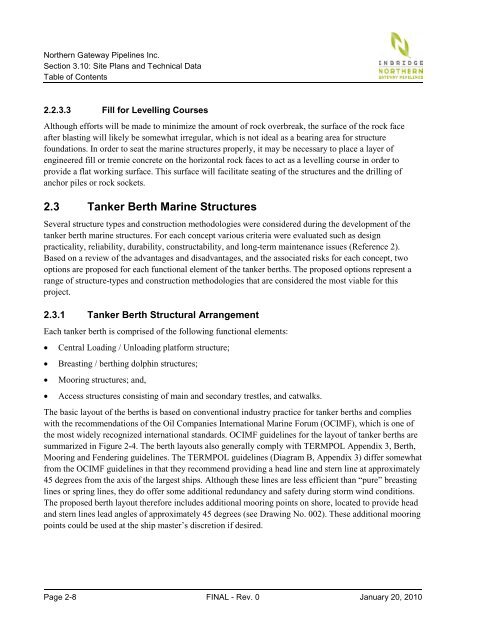Section 3.10: Site Plans and Technical Data - Rick Neufeld Comments
Section 3.10: Site Plans and Technical Data - Rick Neufeld Comments
Section 3.10: Site Plans and Technical Data - Rick Neufeld Comments
You also want an ePaper? Increase the reach of your titles
YUMPU automatically turns print PDFs into web optimized ePapers that Google loves.
Northern Gateway Pipelines Inc.<br />
<strong>Section</strong> <strong>3.10</strong>: <strong>Site</strong> <strong>Plans</strong> <strong>and</strong> <strong>Technical</strong> <strong>Data</strong><br />
Table of Contents<br />
2.2.3.3 Fill for Levelling Courses<br />
Although efforts will be made to minimize the amount of rock overbreak, the surface of the rock face<br />
after blasting will likely be somewhat irregular, which is not ideal as a bearing area for structure<br />
foundations. In order to seat the marine structures properly, it may be necessary to place a layer of<br />
engineered fill or tremie concrete on the horizontal rock faces to act as a levelling course in order to<br />
provide a flat working surface. This surface will facilitate seating of the structures <strong>and</strong> the drilling of<br />
anchor piles or rock sockets.<br />
2.3 Tanker Berth Marine Structures<br />
Several structure types <strong>and</strong> construction methodologies were considered during the development of the<br />
tanker berth marine structures. For each concept various criteria were evaluated such as design<br />
practicality, reliability, durability, constructability, <strong>and</strong> long-term maintenance issues (Reference 2).<br />
Based on a review of the advantages <strong>and</strong> disadvantages, <strong>and</strong> the associated risks for each concept, two<br />
options are proposed for each functional element of the tanker berths. The proposed options represent a<br />
range of structure-types <strong>and</strong> construction methodologies that are considered the most viable for this<br />
project.<br />
2.3.1 Tanker Berth Structural Arrangement<br />
Each tanker berth is comprised of the following functional elements:<br />
• Central Loading / Unloading platform structure;<br />
• Breasting / berthing dolphin structures;<br />
• Mooring structures; <strong>and</strong>,<br />
• Access structures consisting of main <strong>and</strong> secondary trestles, <strong>and</strong> catwalks.<br />
The basic layout of the berths is based on conventional industry practice for tanker berths <strong>and</strong> complies<br />
with the recommendations of the Oil Companies International Marine Forum (OCIMF), which is one of<br />
the most widely recognized international st<strong>and</strong>ards. OCIMF guidelines for the layout of tanker berths are<br />
summarized in Figure 2-4. The berth layouts also generally comply with TERMPOL Appendix 3, Berth,<br />
Mooring <strong>and</strong> Fendering guidelines. The TERMPOL guidelines (Diagram B, Appendix 3) differ somewhat<br />
from the OCIMF guidelines in that they recommend providing a head line <strong>and</strong> stern line at approximately<br />
45 degrees from the axis of the largest ships. Although these lines are less efficient than “pure” breasting<br />
lines or spring lines, they do offer some additional redundancy <strong>and</strong> safety during storm wind conditions.<br />
The proposed berth layout therefore includes additional mooring points on shore, located to provide head<br />
<strong>and</strong> stern lines lead angles of approximately 45 degrees (see Drawing No. 002). These additional mooring<br />
points could be used at the ship master’s discretion if desired.<br />
Page 2-8 FINAL - Rev. 0 January 20, 2010
















